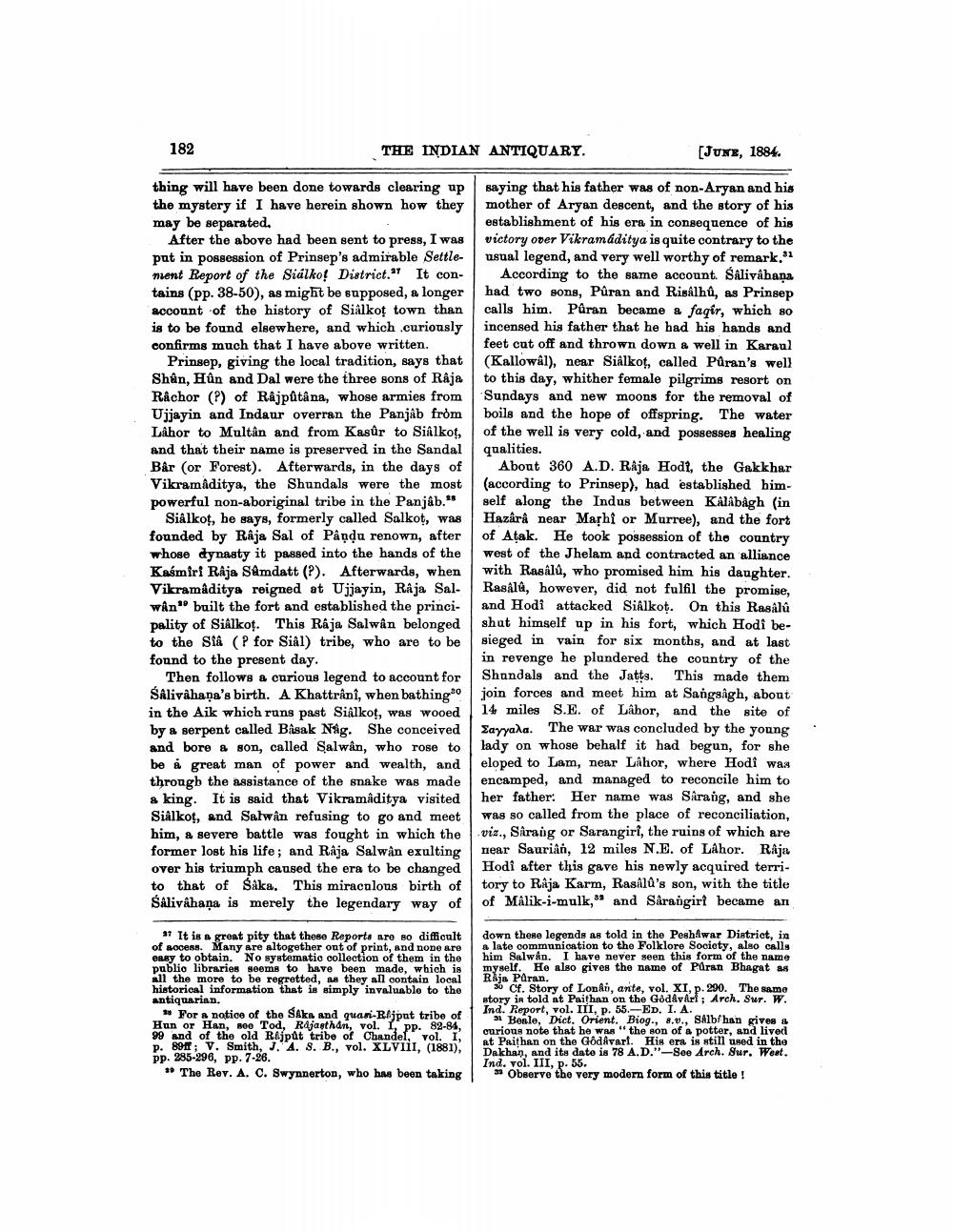________________
182
THE INDIAN ANTIQUARY.
[JUNE, 1884.
thing will have been done towards clearing up the mystery if I have herein shown how they may be separated,
After the above had been sent to press, I was put in possession of Prinsep's admirable Settlenient Report of the Sialkol District. It contains (pp. 38-50), as might be supposed, a longer account of the history of Sialkot town than is to be found elsewhere, and which curiously confirms much that I have above written.
Prinsep, giving the local tradition, says that Shân, Hûn and Dal were the three sons of Raja Råchor (P) of Rajputâna, whose armies from Ujjayin and Indaur overran the Panjab from Låhor to Multân and from Kasur to Sialkot, and that their name is preserved in the Sandal Bår (or Forest). Afterwards, in the days of Vikramaditya, the Shundals were the most powerful non-aboriginal tribe in the Panjab."
Sialkot, he says, formerly called Salkot, was founded by Raja Sal of Pånda renown, after whose dynasty it passed into the hands of the Kasmiri Raja Sümdatt (?). Afterwards, when Vikramaditya reigned at Ujjayin, Raja Sal. Wên" built the fort and established the principality of Sialkot. This Raja Salwan belonged to the Sta (P for Sial) tribe, who are to be found to the present day.
Then follows a carious legend to account for SAlivahana's birth. A Khattrânî, when bathing * in the Aik which runs past Sialkot, was wooed by & serpent called Bisak Någ. She conceived and bore a son, called Salwân, who rose to be a great man of power and wealth, and through the assistance of the snake was made a king. It is said that Vikramaditya visited Sialkot, and Salwan refusing to go and meet him, a severe battle was fought in which the former lost his life; and Raja Salwan exulting over his triumph caused the era to be changed to that of Såka. This miraculous birth of Salivahana is merely the legendary way of
saying that his father was of non-Aryan and his mother of Aryan descent, and the story of his establishment of his era in consequence of his victory over Vikramaditya is quite contrary to the usual legend, and very well worthy of remark."
According to the same account. Salivabama had two sons, Puran and Risálhů, as Prinsep calls him. Pûran became a faqir, which so incensed his father that he had his hands and feet cut off and thrown down a well in Karaul (Kallowal), near Sialkot, called Půran's well to this day, whither female pilgrims resort on Sundays and new moons for the removal of boils and the hope of offspring. The water of the well is very cold, and possesses healing qualities.
About 360 A.D. Raja Hodi, the Gakkhar (according to Prinsep), had established himself along the Indus between Kalibågh (in Hazárå near Marhi or Murree), and the fort of Atak. He took possession of the country west of the Jhelam and contracted an alliance with Rasalu, who promised him his daughter. Rasald, however, did not fulfil the promise, and Hodi attacked SiAlkot. On this Rasálů shut himself up in his fort, which Hodî besieged in vain for six months, and at last in revenge he plundered the country of the Shandals and the Jatts. This made them join forces and meet him at Sangságh, about 14 miles S.E. of Lahor, and the site of Sayyala. The war was concluded by the young lady on whose behalf it had begun, for she eloped to Lam, near Lahor, where Hodi was encamped, and managed to reconcile him to her father: Her name was Sarang, and she was so called from the place of reconciliation, viz., Sarang or Sarangiri, the ruins of which are near Sauriản, 12 miles N.E. of Lahor. Raja Hodi after this gave his newly acquired territory to Raja Karm, Rasåld's son, with the title of Malik-i-mulk, and Sarangirt became an
17 It is a great pity that these Reports are so difficult of socess. Many are altogether ont of print, and none are easy to obtain. No systematic collection of them in the publio libraries seems to have been made, which is all the more to be regretted, as they all contain local historical information that is simply invaluable to the antiquarian.
* For a notice of the Saks and quasi-bjput tribe of Hun or Han, Tod, Rajasthan, vol. 1, pp. 82-84, 99 and of the old Rajput tribe of Chandel, vol. I, p. 891; V. Smith, J. A. S. B., vol. XLVIII, (1881), pp. 285-296, pp. 7-26.
** The Rev. A. 0. Swynnerton, who has been taking
down these legends as told in the Peshwar District, in a late communication to the Folklore Society, also calls him Salwån. I have never seen this form of the name myself. He also gives the name of Puran Bhagat as Raja Paran,
30 Cf. Story of Lonan, ante, vol. XI, p. 290. The same story in told at Paithan on the God&viri: Arch. Sur. W. Ind. Report, vol. III, p. 55.- ED. I. A.
1 Beale, Drict. Orient. Biog., 80., SAlbfhan gives & curious note that he was the son of a potter, and lived at Paithan on the Gôdåvarl. His era is still used in the Dakhan, and its date is 78 A.D."-See Arch. Sur. West. Ind. vol. III, p. 55.
Observe the very modern form of this title !




